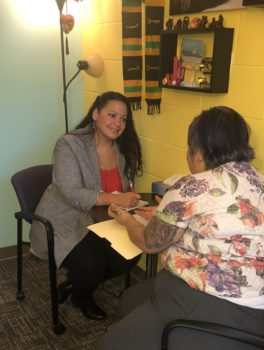
Jaydeen Santos (left) helping a student.
The students who walk into the office of Jaydeen Santos at the University of Vermont are burdened by a familiar litany of troubles.
Santos, the student services advisor at UVM’s Mosaic Center for Students of Color, knows just how they feel. Because 17 years ago, she was right there with them, among the first students in a groundbreaking partnership with Christopher Columbus High School in the Bronx that had been launched by CFES Brilliant Pathways to help underserved students get into college and diversify UVM’s predominantly white campus. But now she’s in a position to help them avoid the same pitfalls she stumbled into.
- Get up and get going! “You need to meet friends, you need to get out of your room, and you need to go to some campus events,” Santos says. She has a hard time remembering which activities she got involved in; the point is simply to get out. At the very least, she says, the student who gets out will feel less alone. More likely, they’ll find something they’re passionate about, meet other people who feel the same way, and soon won’t have time to feel homesick.
- You don’t have to go it alone. When Santos was a first-year student, college classes were new and a struggle. “I got Fs,” she recalls. “I didn’t understand how to figure it all out, and I didn’t understand how to ask for help if it got overwhelming.” Often, the advice she gives new students seems basic. But for first-generation students who don’t have any experience navigating academia, the notion of asking for an extension on a paper or the point of attending office hours can be foreign. The worst thing possible, she says, is to quit going to class and hide from professors—like she did.
- More than anything, she says, students should realize: Colleges and universities like UVM want students to thrive, and have established resources to help students deal with all kinds of challenges—academic, social and financial. Don’t have enough money for books? Feel awkward writing an email to a faculty member? Santos, and others in her position, can help students solve the problem. “A lot of students feel like they’re bothering us, asking for help,” Santos says. “This is my job—my job is to be here for students who need me.”
When Santos started at UVM, many of the mechanisms to help students navigate college didn’t exist. In fact, when she arrived, there were so few students of color (just 4% of all UVM undergrads) that she felt like she knew every single one.
That’s changed, and the partnership with the high school in the Bronx is one reason why. When it launched, UVM wanted to diversify its student population, and the principal of the high school was eager to give students opportunities they couldn’t necessarily find in the Bronx. CFES President Rick Dalton says the resulting partnership has now brought more than 400 students to UVM. (Today, UVM reports 11% of undergraduates are students of color, as well as 10% of graduate students and 32% of medical students.)
This fall, CFES recognized three of the people who made that Bronx partnership possible: former Columbus Principal Gerald Garfin, former UVM Admissions Dean Don Honeman and former UVM Vice President Thomas Gustafson. UVM President Thomas Sullivan credited the relationship with turning the campus into a more diverse, welcoming community. “Our partnership has developed a path that leads to student success,” he told a group of more than 300 educators, students, industry leaders and others attending the CFES annual conference.
Jon Reidel is director of advancement at CFES Brilliant Pathways.
[ssba]
